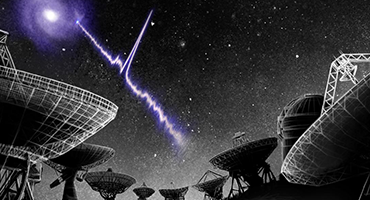CHIME Fast Radio Burst Team to Receive 2022 Berkeley Prize

Congratulations to the CHIME Fast Radio Burst Team, which will receive the 2022 Lancelot M. Berkeley − New York Community Trust Prize for Meritorious Work in Astronomy. The CHIME FRB Team includes PHAS researchers Mark Halpern, Gary Hinshaw, and Ingrid Stairs.
The team is awarded the Berkeley prize for its dramatic progress on fast radio bursts — brief and powerful flashes of radio waves with enigmatic origins — using observations from the CHIME radio telescope in British Columbia. Though fast radio bursts were discovered in 2007, until recently, only about 140 of them had been found. During the past year, the CHIME/FRB team has presented detections that more than quadruple that number.
CHIME is a large, stationary radio telescope with a broad collecting area, wide bandwidth, and enormous instantaneous field of view (roughly 200 square degrees, equivalent to the area covered by more than 1,000 full Moons). "CHIME's revolutionary design enables it to do many experiments simultaneously, and its wide field of view makes it ideal for both mapping the cosmos and detecting transient sources," says Mark Halpern, Principal Investigator of CHIME.
"CHIME/FRB detects roughly 1,000 fast radio bursts per year, which provides a fantastic data set with which to study the origin of these mysterious objects and to explore the structure and composition of the universe," adds Victoria Kaspi of McGill Physics and Principal Investigator of the CHIME/FRB Team. She will accept the award on behalf of the team with Paul Scholz (University of Toronto); they will jointly give the prize lecture during the 239th AAS meeting on Thursday afternoon, 13 January 2022, at the Salt Palace Convention Center in Salt Lake City.
Congratulations again to the CHIME/FRB team!
About the Berkeley Prize
Bestowed annually since 2011 by the American Astronomical Society (AAS) and supported by a grant from the New York Community Trust, the Berkeley prize includes a monetary award and an invitation to give the closing plenary lecture at the AAS winter meeting, often called the “Super Bowl of Astronomy.” The 239th AAS meeting will be held in Salt Lake City, Utah, from 9 to 13 January 2022.
Each year the three AAS Vice-Presidents, in consultation with the Editor in Chief of the AAS journals, select the Berkeley prize winner for meritorious research published within the preceding 12 months. The CHIME/FRB team is recognized in particular for an article published in Nature in November 2020 that identified the first known fast radio burst within our own galaxy and tied this flash to its potential source, a known magnetar in the Milky Way. This work has shown that at least some fast radio bursts may originate from young, active magnetars — highly magnetized and dense remnants of massive stars.
About CHIME
CHIME was designed, built and is operated by a collaborative group of cosmologists, high-energy astrophysicists, engineers and programmers, including many students. The CHIME team, led by physicists at UBC, McGill, U of T and the National Research Council's (NRC) Dominion Radio Astrophysical Observatory (DRAO), continues the tradition that cosmology instruments are built by the scientists who use them, and in doing so, trains the next generation of researchers. The team designed a 1-hectare radio telescope to scan the entire northern sky with no moving parts. The team also designed custom high speed electronics to capture the radio signals and programmed a network consisting literally of five truckloads of computers to sift through the avalanche of data which CHIME produces. As a team, they operate CHIME around the clock. This innovation would not have been possible without the help of the very talented staff at the DRAO.
The CHIME team also received the 2020 Governor General's Innovation Award.
Read more
- CHIME Fast Radio Burst Team to Receive 2022 Berkeley Prize (American Astronomical Society release)
- CHIME Fast Radio Burst Team to Receive 2022 Berkeley Prize (McGill University release)
- The Canadian Hydrogen Intensity Mapping Experiment website
Related news
- Canadian telescope detects 500 fast radio bursts in a year, quadrupling number of known FRBs (June 8, 2021)
- CHIME telescope detects second-ever repeating fast radio burst (January 9, 2019)
- Mysterious fast radio burst tracked down to nearby galaxy (January 7, 2020)